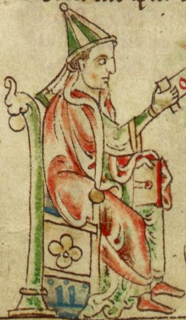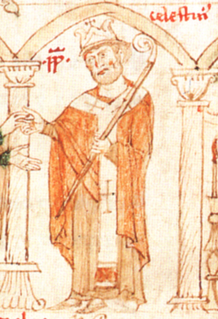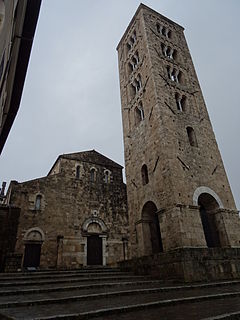Family and papal curia
Pandulf was a native of Anagni. He appears in Latin sources as Pandulfus de Anagnia before his election as bishop. He belonged to the family of Conti di Anagni, a branch of the counts of Segni. He was probably related to Pope Gregory IX, who was also from Anagni.
Pandulf was as a subdeacon and chaplain in the Roman curia under Gregory IX. In Gregory's biography in the Liber censuum , he is described as an "experienced" military man (experate providentie virum cum militum). The Liber's modern editor, Carlo Alberto Garufi [ it ], misidentified the chaplain Pandulf with Bishop Pandulf of Patti (1235–1244). Both were active in the service of Gregory IX at the same time. Unlike the future bishop of Patti, however, the chaplain is never described as a papal notary. Although he is sometimes identified with the Master Pandulf who served Honorius III, this was more likely the future bishop of Patti.
Military commander
When the pope waged war on the Emperor Frederick II in 1228–1230, Gregory appointed Pandulf as his apostolic legate over the three armies and named him rector of Marittima e Campagna. Pandulf personally took command of the southern force and invaded the Kingdom of Sicily, forcing his way across the Liri at Ceprano on 18 January 1229. He had under him two Sicilian exiles as his captains, Counts Thomas of Molise and Roger of Aquila. His army consisted mainly of infantry raised in the Papal States.
Pandulf's initial advance was highly successful. The Liber celebrates his defeat of the Justiciar Henry of Morra "with just a few infantry and God on his side". He took Monte Cassino after fierce fighting. Resuming his advance in March, he took Gaeta, laid siege to Capua, took Alife and Telese, and joined up with the papal troops of Benevento. Advancing down the Garigliano, he met stiff resistance at Suessa, where he was replaced as legate by Cardinal Pelagius of Albano for reasons unknown. Suessa fell to Pelagius in May. Sometime after his demotion, Pandulf is found among the supporters of Frederick.

Pope Gregory IX was Bishop of Rome and hence head of the Catholic Church and ruler of the Papal States from 19 March 1227 till his death. He is known for issuing the Decretales and instituting the Papal Inquisition, in response to the failures of the episcopal inquisitions established during the time of Pope Lucius III, by means of the papal bull Ad abolendam, issued in 1184.

Pope Innocent IV, born Sinibaldo Fieschi, was head of the Catholic Church and ruler of the Papal States from 25 June 1243 to his death in 1254.

Pope Nicholas III, born Giovanni Gaetano Orsini, was head of the Catholic Church and ruler of the Papal States from 25 November 1277 to his death.
Pelagio Galvani was a Leonese cardinal, and canon lawyer. He became a papal legate and leader of the Fifth Crusade.
John Halgren of Abbeville was a French scholastic theologian and cleric. He served successively as a university professor, priest, prior, archbishop, cardinal, apostolic legate and diplomat.
Gerardo Allucingoli was an Italian cardinal and cardinal-nephew of Pope Lucius III, who elevated him in 1182.

The Diocese of Anagni-Alatri is a Latin Church ecclesiastical territory or diocese of the Catholic Church in Lazio, Italy. It has existed in its current form since 1986. In that year the Diocese of Alatri was united to the historical Diocese of Anagni. The diocese is immediately exempt to the Holy See.
The 1241 papal election saw the election of Cardinal Goffredo da Castiglione as Pope Celestine IV. The election took place during the first of many protracted sede vacantes of the Middle Ages, and like many of them was characterized by disputes between popes and the Holy Roman Emperor. Specifically, the election took place during the war between Frederick II, Holy Roman Emperor and the Lombard League and deceased pontiff, Pope Gregory IX, with Italy divided between pro-Papal and pro-Imperial factions known as the Guelphs and Ghibellines.

The 1227 papal election, was convoked after the death of Pope Honorius III on 18 March 1227 at Rome.
The 1254 papal election took place following the death of Pope Innocent IV and ended with the choice of Raynaldus de' Conti, who took the name Pope Alexander IV. The election was held in Naples, in the former palazzo of Pietro della Vigna, and required only one day.

The 1261 papal election took place after the death of Pope Alexander IV on 25 May and chose Pope Urban IV as his successor. Since Pope Alexander had been resident in Viterbo since the first week of May 1261, the meeting of the cardinals to elect his successor took place in the Episcopal Palace at Viterbo, which was next to the Cathedral of S. Lorenzo. The actual date of the beginning of the Electoral Meeting is unknown. If the canon of Pope Boniface III were still in effect, then the Election could not begin until the third day after the Pope's burial.

The 1191 papal election took place after the death of Pope Clement III. Pope Clement, according to differing and irreconcilable reports, died in March 1191, in the last third of the month, on the 20th, the 25th, the 26th, the 28th, or perhaps 2 April or 4 April, or 10 April. The election was conducted during the march of King Henry VI and his army toward Rome. The 85-year-old Cardinal Giacinto Bobone, a member of the Orsini family, was chosen after some extreme reluctance. He took the name Celestine III. Pressed by the Romans, however, he agreed to negotiate with King Henry about his coronation as emperor and about the possession of the city of Tusculum. Celestine postponed his own consecration in order to buy time to negotiate. He was finally crowned on Easter Sunday, 14 April 1191.

Anagni Cathedral is a Catholic cathedral in Anagni, Lazio, Italy, notable as the summer residence of the Popes for centuries. Home to the cathedra of the Diocese of Anagni-Alatri, it is a Marian church dedicated to the Annunciation of the Blessed Virgin Mary.

Pietro Diani was an Italian cardinal. The name "Diana" is incorrect; he signs himself Petrus Dianus.
Enrico Filangieri was an Italian nobleman and Dominican friar who served as the archbishop of Bari in the Kingdom of Sicily from May 1252 until his death.

The Palace of the Popes in Anagni, sometimes called the Boniface VIII Palace (Palazzo Bonifacio VIII), is a building in the ancient hill town of Anagni in central Italy, in the hills east-southeast of Rome. It is closely associated in history with Pope Boniface VIII, was later bought by his nephew Peter II Caetani, and now houses a museum named after the Pope. It is at present part of a property owned by the Cistercian Sisters of Charity and used in part as their motherhouse.

The War of the Keys (1228–1230) was the first military conflict between Frederick II, Holy Roman Emperor, and the Papacy. Fighting took place in central and southern Italy. The Papacy made strong gains at first, securing the Papal States and invading the Kingdom of Sicily, while Frederick was away on the Sixth Crusade. Upon his return, he defeated the papal forces, forcing Pope Gregory IX to begin peace talks. After drawn-out negotiations, the treaty of San Germano terminated the conflict with no territorial changes.
Stephen of Anagni was an Italian priest in papal service.










